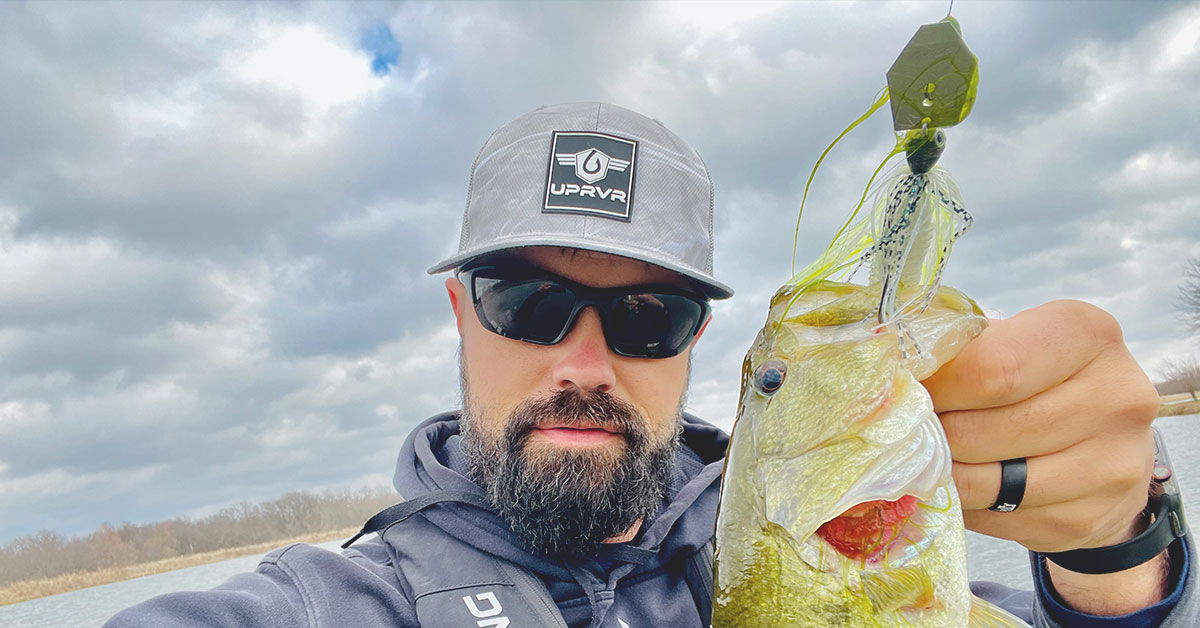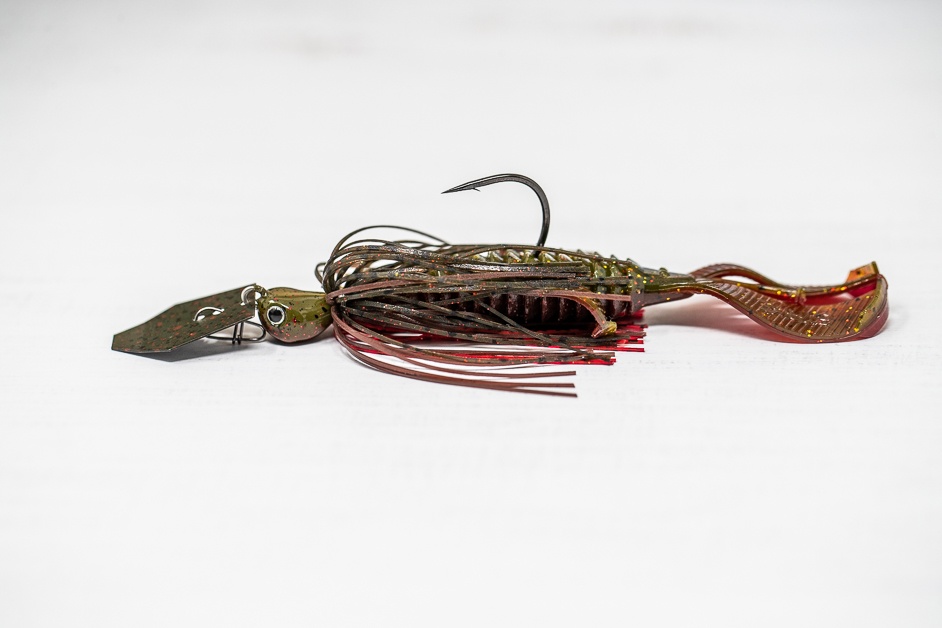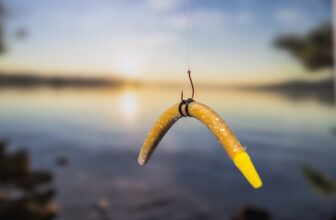
The chatterbait has become a staple in any professional angler’s arsenal and for good reason – it catches fish. With its roots dating back to the early 2000s, this vibrating bladed jig has undoubtedly changed the world of bass fishing more than any other tackle innovation in the past three decades, and arguably ever. Find out more below on how to fish a chatterbait, it’s history and why we believe it’s one of the most versatile lures on the market!
What is Chatterbait?
Chatterbait is the name brand of a bladed vibrating jig and was the first one to hit the market in 2004. Despite this, people generally refer to any bladed vibrating jig as a Chatterbait – you might also hear them being called a bladed jig, vibrating jig, or swim jig. This bait is as versatile on the water as the name you choose to call it and I recommend you always have one ready to go.
Chatterbaits are essentially a weighted jig head adorned with a flowing skirt-the key difference is the blade attached to the head of the jig that when reeled causes the bait to vibrate or kick back and forth which mimics baitfish and triggers a predatorial instinct largemouth bass cant resist. Different plastic trailers are used to mimic different fish or crawdads and should be changed according to the season, watercolor, and other factors that directly influence the behavior of bass.
Origin
Ron Davis from Rockhill South Carolina is the man behind the original Chatterbait and after years of tinkering with the design, he started selling it in 2004. Although it would become an overnight success two years after the initial release, it was met with skepticism at first. This overnight success came in January of 2006 on lake Okeechobee when Bryan Thrift promised Ron Davis that he would mention the Chatterbait if it worked for him. Well, it worked, and after Thrift won the tournament throwing a Chatterbait the orders came flooding in and haven’t slowed down since.
In 2007 Z-Man bought the rights to the original Chatterbait and to this day continue to innovate upon and manufacture the original design. Since then Z-Man has created an entire line of chatterbaits including the Elite and the Jackhammer models. Other companies have followed suit and produce their own version of the vibrating bladed jig but Z-Man is the only company with the original Chatterbait title.
Another key event in the success and popularity of the Chatterbait is when Brett Hite caught just over 90 pounds of fish in four days on one. Winning the tournament and plugging the Chatterbait, Hite was able to lay the remaining skeptics to rest and continues to heavily advocate for and throw this lure today.
How to Fish A Chatterbait
Fishing a Chatterbait or other similar bladed jigs has become standard practice in today’s bass fishing world and this can be attributed to the year-round success and versatility of this type of lure. When broken down you start to notice all of the different attributes that the Chatterbait achieves with just a single lure. It has the vibrating wobble of a traditional crankbait while the blade somewhat resembles the spinning blade on a spinnerbait. The final mimicking touches are achieved through the combination of the skirt color on the jig and the trailer you decide to go with.
How to Work a Chatterbait
There are three main ways to fish the retrieve with one of these lures and the most effective answer for how to work a chatterbait is usually a direct correlation with what time of the year it is. In the warmer months, a steady retrieve higher in the water column is ideal. In the cooler months, the most effective retrieval is either a slow steady retrieve low in the water column or a jigging retrieval allowing the lure to bounce along the bottom. Check out this video from Tactical Bassin’ on how to fish a chatterbait with more details and techniques to try out!
Chatterbait Rods
When fishing a Chatterbait or other bladed jigs you want to use a longer rod preferably one that’s 7’0 or slightly longer. By using a longer rod you can cast the Chatter further and more accurately. In addition to cast accuracy, the longer rod allows for increased sensitivity which can be the difference between hooking a bass or missing it.
Fiberglass is my preferred rod material when fishing a bladed jig because they have more play in them than graphite rods. This comes in handy with a Chatterbait because most of the time when a bass hits one they do it instinctually and they hit it hard. These types of strikes can result in a hook being pulled away from the fish when you are using a stiffer graphite rod. One of the main reasons anglers choose to go with graphite over fiberglass is for the increased sensitivity but with a 7’0 fiberglass rod, there is plenty of sensitivity to feel your bait thumping and the fish striking.
Chatterbait Line
There are a couple of different options for lines to use with a Chatterbait and the odds of getting the same answer from multiple anglers is slim. When it comes down to it you are going to want to use either a fluorocarbon or braided line. Fluorocarbon line is nearly impossible for the fish to detect underwater which makes it ideal for lighter colored bodies of water.
Braided line is the strongest line out there which makes it great for fishing thick cover but the line itself is highly visible. If you choose to throw a chatter on a braided line I recommend tying it to a fluorocarbon or mono lead. This gives you the strength of braid with the concealment of mono or fluorocarbon lines.
When to Fish a Chatterbait
Arguably one of the best perks of fishing bladed jigs is their year-round versatility. By adapting the color scheme of your jig and trailer to match whatever the bass are currently feeding on, and changing where you throw it, you can guarantee catches on the hottest summer or coldest winter days, and everything in between.
On top of being able to fish the chatter during any season, it’s versatile in its placement as well. It works wonders anywhere you think a bass might be hiding – it works great around grassy areas, docks, rocks, logs, and any other underwater structure that a bass might be held up in waiting for their ambush instinct to be triggered.
Winter
Fishing in the wintertime isn’t for everybody, but that doesn’t mean it can’t be done. When I’m throwing a chatter in the winter months I focus on the deeper waters because that’s obviously where the bass are this time of the year. I imitate whatever baitfish are in the area, a straightforward tactic commonly referred to by anglers as match the hatch.
Once I know what color scheme I’m going to go with I rig up a ½ or ¾ ounce jig more suitable for fishing in deeper waters. I find that throwing a chatter in the winter is most successful when targeting drop-off points and grassy areas where the sluggish winter bass typically wait in ambush.
When fishing a bladed jig in deeper winter waters your retrieve is going to be slower and steadier than in the warmer months. Similar to slow-rolling a spinnerbait. After letting the bait sink to the lower water level you can begin the slow and steady retrieve back to the boat. If you’re swimming it through grass the occasional jerk when you get hung up can work wonders as well.
Spring
As the water starts to warm up and the fish start moving back towards shallow waters I like to throw a slightly lighter ⅜ ounce jig. My ideal location for springtime chatter fishing is shallower grassy spots that run perpendicular to deeper waters. I swim the bait along the top of the grass occasionally letting it sink just below the grass line. I recommend a steady retrieve with an uninterrupted thumping to trigger the hungry springtime bass.
Summer
There aren’t many if any restrictions to chatter fishing in the summer. I usually throw either a ¼ or ⅜ ounce jig fit for shallower water fishing and I put it anywhere there is cover. My main goal in the summer is to cover as much water and as much different cover as I can until I find out where the fish are hiding. A straight and fast retrieve seems to work best for me this time of the year.
I find that I have the best luck in the summertime months when I’m throwing a darker lure and trailer be it black and blue, chartreuse, or green-pumpkin. If you know what the fish are feeding on your best bet is to imitate that, but if you don’t, or it just doesn’t seem to be working, try out different combinations until you find what they’re eating.
Fall
As the waters start to cool back down in the fall I revert to many of my springtime tactics for throwing a Chatterbait. I target grassy drop-offs and I imitate the light pattern of a shad baitfish. I opt for a steady retrieve just above the grasstops on thicker patches or just under the tops through thinner patches.
Closing
The story of the Chatterbait is an impressive one – from its humble and incredibly doubtful beginnings nearly two decades ago, to the raging success it has become today. I recommend every angler stay loaded with a chatter tied onto a rod or two because this bait works anytime and anywhere. Whether you’re out there in the heat of the summer or trying to pull out those deeper wintertime bass, there is a jig and trailer combination that can land you monsters any time of the year. If you’d like more tips on how to fish a chatterbait stay tuned for future videos and guides and let us know in the comments below what other questions or comments you might have!








